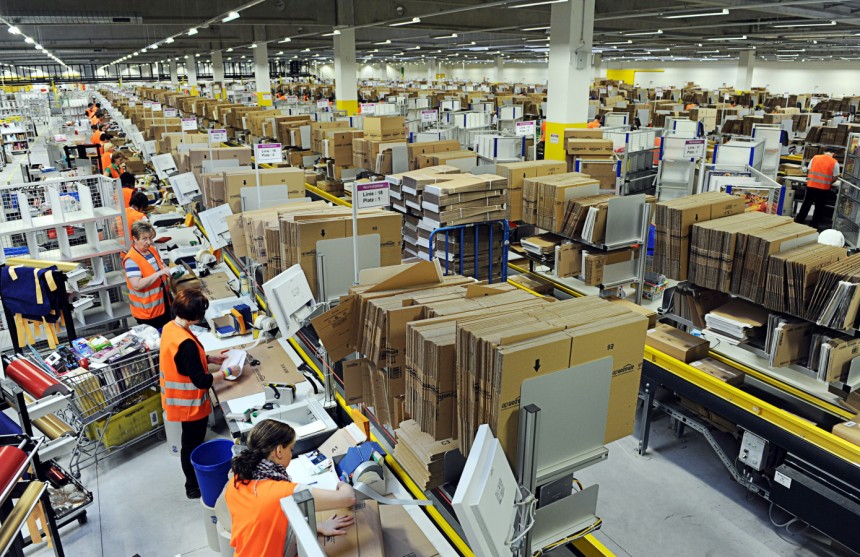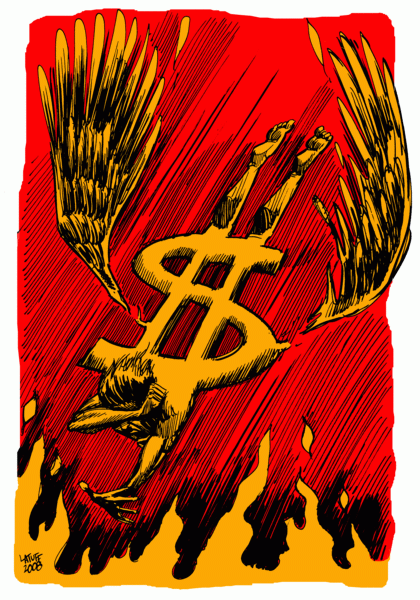
This article is a transcript of the presentation given by Vincent R. Beaudoin at Fightback’s Marxist Winter School 2021.
When the Soviet Union collapsed in 1991, Francis Fukuyama told us that this was evidence of the failure of the planned economy and the success of the capitalist market economy, and that it represented the end of history. In October 2018, however, he changed his mind. He recognized that the neoliberal period, which began with Ronald Reagan and Margaret Thatcher, promoting the benefits of an undirected market, had had disastrous effects. He also recognized that Marx was right when he said that capitalism leads to crises of overproduction that impoverish the workers and propel a class of oligarchs to power, who will make the workers pay for the crisis. It was Fukuyama who said all this!
Although capitalism has been going into crisis every 10 years or so for 200 years, and impoverishing the workers every time, Fukuyama had to see the effects of the 2008 global crisis for himself to understand the relevance of the Marxist analysis. In 2008, the banking sector collapsed as a result of a crisis of overproduction. The “invisible hand of the market” did not save the capitalists. It was the state that rescued the banks by gifting billions of dollars to them, which was paid for by the workers in the form of austerity in the decade that followed.
The current COVID-19 pandemic also shows the limits of the capitalist market. Business owners have pressured governments to leave non-essential businesses open. Workers were thus forced to work in unsafe, unsanitary conditions so that the bosses could continue to make a profit. And the big bosses made a lot of profit.
Since the beginning of the pandemic, Canadian billionaires have become nearly $40 billion richer, and American billionaires have become $637 billion richer, while 40 million American workers have applied for unemployment benefits. Between March and September of 2020, former Amazon CEO Jeff Bezos became $74 billion richer, and now has a fortune of $200 billion. Bezos now makes more money per second than the average American worker makes in a week. What an American worker will earn in a lifetime, about $2.2 million, Bezos makes in 15 minutes. Since the beginning of the COVID-19 pandemic, workers around the world have lost $3.7 trillion and billionaires have gained $3.9 trillion.
In the pandemic there is a contradiction between the needs of the market economy, and the needs of public health. Bosses cannot close non-essential businesses and continue to pay workers wages. If they had done so, they would have gone bankrupt. It was the state that bailed out these companies with wage subsidies and other handouts, while also providing a subsistence income to the workers through emergency benefits like the Canadian Emergency Response Benefit (CERB). The Canadian government has paid out hundreds of billions of dollars to save corporate profits, a huge amount of money that will have to be paid back by the workers in the form of taxes, inflation and austerity.
Conversely, if we lived in a socialist planned economy, where corporations are nationalized under the democratic control of the workers, we would have quickly closed down all non-essential workplaces and continued to provide full wages to the workers. No company would have gone bankrupt. The virus would have been contained from the beginning, and at this point the pandemic would probably be a thing of the past.
Listen to this presentation on Spotify:
The problem of economic calculation

The central question of the current article is: What is the best economic system for the efficient distribution of goods and services—a capitalist market economy or a socialist planned economy?
This debate has been formulated notably through the writings of the economist Ludwig von Mises, in the early 1920s, then developed by the economist Friedrich Hayek. This debate is referred to as the “economic calculation problem” or the “socialist calculation debate.”
Mises’ thesis is that in a large-scale economy, a socialist planning council would be unable to obtain and calculate all the information necessary to know what products to produce and in what quantity, and how to distribute them. And so socialist planning would create mismatches between supply and demand, and lead to shortages, famine, chaos, etc. For Mises, the solution is simple: we need a market economy, in which private companies compete with each other. Through competition, the law of supply and demand is exercised, which, according to Mises, makes it possible to set the prices of commodities.
In the end, we find in Mises the same old idea of Adam Smith’s “invisible hand” of the market. According to Adam Smith, individuals make decisions to buy or sell for their own benefit, and they are thus directed by an “invisible hand” that allows them to achieve an end that they did not want, namely the well-being of society as a whole, thanks to the market system.
According to Mises, commodity prices allow for the spontaneous calculation of information from all aspects of production and distribution, from production costs to changes in consumer needs. According to him, the market decentralizes the vast amount of information that a single planner could not compile and calculate.
We often hear the idea that socialism works in theory, works only on paper, but not in practice. Mises wanted to show that socialism does not even work in theory. There is something wrong with his idea, however, and perhaps it is only recently that it can be demonstrated: economic planning is a fundamental pillar of production for large companies. In their book, The People’s Republic of Walmart, Leigh Phillips and Michael Rozworski explain how the case of Walmart demonstrates that economic planning works in practice, and shows how a socialist economy would surpass capitalism in efficiency.
Walmart: an internal planned economy

Walmart has become the largest company in the world. It operates 11,000 stores in 27 countries, and employs more people than any private company. If state-owned enterprises are included in the calculation, Walmart is the third largest employer in the world after the US Department of Defense and the Chinese People’s Liberation Army. If Walmart were a country, its economy would be about the size of Sweden or Switzerland.
Although Walmart operates in the market, within Walmart there is no market, everything is planned. The different departments, stores, suppliers, etc., are not competing with each other in a market: they are all coordinated together. Walmart is not just a planned economy, but a planned economy the size of the USSR during the middle of the Cold War. In 1970, the GDP of the USSR was $433.5 billion in today’s money, and was then the 2nd largest economy in the world, while Walmart in 2017 had an income of $485 billion, which is much larger.
If Mises were right, then Walmart wouldn’t exist, because it would have hit the wall of “too many calculations.” In addition, there are hundreds of multinational companies similar to Walmart, which are planned economies.
But let me make it clear at the outset that these companies, including Walmart, do not represent socialist workplace models for socialists. These companies operate solely for profit, and the bosses impose disgusting conditions on their employees. The employees have to endure the dictatorship of the bosses and are reduced to mere extensions of the machines. But it must be recognized that Walmart has made some pretty revolutionary advances in how it integrates its supply chains into a more or less harmonious, fully planned network. Let me explain this idea.
The bullwhip effect
Let’s start with a small retailer or store that has nothing to do with Walmart. The retailer usually deals with distributors to obtain its commodities, and the distributors buy from producers. Together they form a supply chain.
The companies in the chain are all autonomous, and together they build business relationships, so they are ultimately competing and ensuring that they maintain their own profit. In this supply chain, it is the retailer who has to coordinate with changes in consumer demand, then adjusts his orders to the distributors accordingly, and the distributors order from the producers.
In 1961, an economic effect was observed to occur in this type of situation, the bullwhip effect. If, for example, demand varies by five per cent, i.e., the store’s customers increase or decrease their purchases for specific products within a five per cent variation, the store must adjust its orders to distributors with a five per cent change. But at the level of the distributor, who may supply several stores, the changes accumulate and this can result in a 10 or 20 per cent change in their inventory. For producers who supply distributors, the variation in demand causes their inventory to vary even more. In relatively complex supply chains, a simple five per cent change in demand at the beginning can result in a 40 per cent change in inventory at the other end of the chain.
Such a variation is enough to result in large excess production that is wasted, or to lead to shortages. It can literally ruin businesses. The bullwhip effect is the fact that a small wave at the beginning of the supply chain starts to amplify and can destabilize the entire chain. The bullwhip effect directly shows the problems of the market and competition, and shows the need for economic planning.
Walmart’s solution to counter the bullwhip effect is to integrate different companies into a harmonious chain, reducing competition between the different levels. At Walmart, demand is managed from the other end of the chain. The seller tells the buyer how much he’s going to buy. The retailer or store leaves it up to the supplier to make decisions about restocking. Manufacturers, who produce, are responsible for managing Walmart’s warehouse inventories. Throughout the chain there is transparency and data sharing technologies are used.
A good counter-example of transparency is Volvo. They produced too many green cars, so the marketing department spent money on advertising to sell more green cars and sell off stock, but they didn’t tell the manufacturing department. So the manufacturing department noticed the increase in the demand for green cars, and increased the production of green cars. They then found themselves with an overproduction of green cars that they could no longer sell.
At Walmart they use Retail Link, a huge database, connected by satellite, which allows the tracking of demand information from cash registers. The database provides information directly to the suppliers, who can adapt their production in real time.
In short, Walmart has developed a whole series of mechanisms to harmonize its supply chain, from production to distribution, and acts like a true planned economy—and it works. The proof lies in their revenue.
As a socialist, one can certainly admire the power of the class enemy, without trying to mimic their tactics. Walmart remains a gigantic dictatorship of bosses and shareholders, and the workers are just cogs in this big machine.
But if Walmart were nationalized under the democratic control of the workers, the workers could use Walmart’s satellites, state-of-the-art computers and databases to plan production and distribution, without shortages or overproduction, and at low cost, since there would be no need to fill the shareholders’ wallets with profits.
On the other hand, workers could decide together how to organize their workplace and provide themselves with decent working conditions. Walmart workers already know how to produce, coordinate and manage production and distribution. They don’t need the bosses. Capitalists are only shareholders and investors who pocket the profit. They don’t manage production, they just parasitize production.
Sears: The Libertarian Failure

There is one company that didn’t understand the reasons for Walmart’s success, and that’s Sears. Nearly 130 years old, and one of Walmart’s main competitors, Sears completely self-destructed in 2018, after adopting a vision totally opposed to Walmart’s: they set up an internal market! Sears has reported losses of $10 billion since 2011. They have closed over 2000 stores.
It all started with CEO Edward Lampert’s libertarian plan to split the company into 40 units competing against each other. The “visionary” Lampert wanted to use Sears as a big free-market experiment, to show that the “invisible hand” would outperform the centralized planning typical of other companies.
Each department had its own president, its own board of directors, and managed its own profits and losses. The CEO’s mantra was that if department heads are told to act selfishly, they will necessarily manage their departments in a rational manner, which will increase the overall performance of the company.
The clothing department, for example, was in competition with the IT department and the human resources department. If they wanted to obtain IT services, they had to sign a commercial contract with them, or else deal with external contractors, if it would increase the financial performance of their department, regardless of whether the decision could have had a positive impact on the company as a whole.
One example is the Kenmore brand of appliances, a Sears product, which was split between the appliance division and the branding division. The former had to pay a fee to the branding division, so they decided to sell products that were not Sears branded, as it was more profitable. So they competed with Kenmore’s branded products and reduced the profits for the overall company.
Other problematic behaviors are worth mentioning, like corporate executives who hid their computer screens during meetings so that other executives would not know what they were working on.
As the company’s overall profits declined, the divisions became even more vicious toward each other. One former executive said that it was like a war between tribes. Journalist Mina Kimes compared Sears to the Hunger Games.
Even now, CEO Lampert hasn’t changed his mind. He tells us that “Decentralized systems and structures work better than centralized ones because they produce better information over time.” Those who have remained in this business management paradigm still think that the conventional model working with planning is simply communism.
In short, once again, we can clearly see the superiority of economic planning and cooperation over free market and competition.
Amazon: managing the chaos

But perhaps you are not yet convinced. So let me tell you about one last company: Amazon. Amazon has built its empire thanks to the internet. It’s the biggest technology company using the fruits of computing to distribute products. Amazon controls almost half of online sales in the USA. They distribute millions of products to millions of people.
Following Walmart’s model, Amazon has even begun to integrate the companies that produce what it sells, by physically placing its workers in the factories and warehouses of its main suppliers. Amazon is a master of planning. Its database and algorithms collect and calculate billions of gigabits of customer information, and provide an extremely detailed picture of what people are buying and when.
When you go online on Amazon’s website, the algorithm calculates a lot of information about you: not only what you buy, but also what you put in your shopping cart without buying, what you look at as a product and how long you spend. Amazon can therefore predict its production based on a demand that exists only in potential and can be realized a little later. It’s as if Amazon knows what you’re going to buy before you even buy it.
On the other hand, we’re talking about such an enormous amount of information that computers have to calculate, what is called “big data”, that Amazon cannot perfectly plan all the factors that will interfere with distribution. Amazon does not fully control all the airplane and ground transportation networks. The challenge is to plan in an orderly way a chaotic collection of information, so to plan just “good enough”, to make approximations, without being perfect. And it works.
In fact, you could say that Amazon excels in the art of “managing chaos.” You can see that with its purchase recommendation system on the website. It’s clearly not perfect, and sometimes the recommendations are weird, but it still helps with distribution planning, because it allows them to estimate demand. A large amount of the products sold are the result of purchase recommendations on the website.
You can also look at how Amazon’s warehouses work to understand what it means to plan in chaos. We are talking about warehouses the size of a soccer field. Warehouses are organized in a process called “chaotic storage.” Commodities are not organized in rows according to their type or broader category. You may have an axe next to dog food.
Each item has a barcode and is stored in roll-out bins that also have a barcode. At any time, the computer knows exactly where each product is, in which bin, in which row. Warehouse workers who need to pick up products are attached to a handheld scanning device that tells them exactly where to pick up the product.
In Amazon’s most technologically advanced warehouses, the worker has been replaced by a robot, which scours the rows and retrieves the products and takes them to a picking station, where workers simply pick up the product and put it in another bin that will go into a truck. In the end, it is the worker who becomes a simple machine or a robot, and that’s not me saying it, it’s what the workers themselves describe.
All the decisions made in distribution are fully planned and coordinated; there is no market involved. The beauty of this planning, however, is accompanied by pure horror for the worker. The worker has no freedom, all his movements are dictated by his scanning device.
In warehouses where there are robots moving the products, the worker doesn’t even move. He is trapped in a small space, and only has to take a product from a bin that the robot brings him, and place it in a bin that will go into a truck. Employees wear wristbands that track their movements and calculate their break time or washroom time.
Not only are workers treated like cattle, they are also paid extremely low wages; not to mention the fact that Amazon pays very little in taxes. It is through all these mechanisms that alienate the worker that Amazon’s shareholders can make huge profits. The working conditions are so disgusting that sometimes, when it gets too hot, Amazon will place paramedics in front of the warehouse to treat employees who get heatstroke.
One thing Amazon cannot plan for is decent working conditions. Amazon is the success of Big Data, and the dictatorship of Big Brother.
After all, Amazon remains a privately held company whose sole purpose is to make a profit for its shareholders. Internal planning is accompanied by horrors because, ultimately, Amazon does not exist in a planned economy but in a market economy, where capitalists compete with each other to make as much profit as possible.
What socialists propose is to nationalize Amazon, as well as all the big companies, under the democratic control of the workers. The workers of Amazon have already understood that Bezos and the shareholders are not the ones who produce. If the workers of Amazon organized the management of the company themselves, they would use many of Amazon’s planning mechanisms, but would put an end to the mechanisms that turn workers into machines, simply because those mechanisms are not in the workers’ interest.
Planning amongst market anarchy
We showed with Walmart and Amazon that planning works well in practice, and already exists under capitalism. The economist Mises’ idea that a planned economy would be incapable of managing the immense amount of information was clearly dismantled by Amazon’s ability to manage its chaos of information.
Basically, the market is one big anarchic chaos where companies compete for the most market share. It’s the reign of the law of the jungle. And in order to be efficient and productive in the market, companies must implement internal economic planning, the opposite of the market.
This contradiction of capitalism is the result of the fact that production has become increasingly social: i.e. it takes hundreds, even thousands, of workers to produce a single gadget and its components. However, this social production remains the private property of a few. This is the main contradiction of capitalism.
The most efficient companies, often the biggest, end up defeating the smallest and least efficient. The “free market” therefore constantly creates its opposite: the tendency to monopolies.
150 years ago, Marx explained that:
The same bourgeois mind which praises division of labour in the workshop, life-long annexation of the labourer to a partial operation, and his complete subjection to capital, as being an organisation of labour that increases its productiveness – that same bourgeois mind denounces with equal vigour every conscious attempt to socially control and regulate the process of production, as an inroad upon such sacred things as the rights of property, freedom and unrestricted play for the bent of the individual capitalist. It is very characteristic that the enthusiastic apologists of the factory system have nothing more damning to urge against a general organisation of the labour of society, than that it would turn all society into one immense factory.
Crises of overproduction

The market economy is in fact a very flawed system for managing the distribution of resources. The complete anarchy of the market generates regular crises of overproduction. Indeed, for about 200 years, the market has been following boom and bust cycles, each lasting about eight to 12 years.
At the beginning of a cycle, capitalists invest because they are confident that they can make a profit. They buy machinery, hire workers, and produce more and more. It is for this phase of capital expansion that structural unemployment exists, to have a pool of workers to hire. As more workers receive a wage, they can buy more, which further encourages capitalists to produce.
At some point, at the top of the curve, there are too many products for the market to absorb. It’s not that the needs of consumers are being met, it’s that the workers, forming the majority of consumers, no longer have enough money to buy back all the commodities produced. This leads to an overproduction of commodities.
The capitalists are no longer able to sell everything, and the commodities will gradually rot or become obsolete. For the capitalist, an unsold commodity is lost profit, and he must maintain a good rate of profit to remain competitive. He must therefore cut his production costs. He will reduce investments, cut production, cut wages, lay off workers, shut down machines and parts of the factory. Some bosses will even destroy commodities, as we have seen in the car and tire industry, thus reducing supply and creating a relative scarcity that allows prices not to fall too much.
When the production curve goes down, it’s a recession or economic crisis, and the workers are the real losers. For the small capitalists, it can mean the bankruptcy of their company and their takeover by a bigger one. For the big capitalists, the recession allows them to purge the unsold surplus, and after the purge, they can start investing again knowing that they will have buyers. And the cycle begins again.
It’s really a fantastic system: Self-regulation by wasting product and destroying workers’ living conditions.
Artificial scarcity
Ultimately, the mechanism at the source of crises of overproduction is the fact that workers are not paid for what they produce, but are paid just enough so that they can eat, house, clothe themselves, etc., and return to work the next day.
For example, a worker in a fast food restaurant may produce $800 worth of meals a day and only get paid $105. Part of the income will be used to pay for machinery and raw materials, and the rest will be the capitalist’s profit.
The worker is therefore unable to buy back what he himself has produced. At the level of the whole of society, the entire working class also becomes, during the boom and bust cycle, incapable of buying back the entirety of production, which leads to overproduction.
The crises of capitalism are therefore a direct consequence of the fact that the workers are exploited by the bosses, and that a large part of the value of the commodities goes back to the capitalists in the form of profits, instead of returning to society.
In the economic systems of the past, such as slavery or feudalism, economic crises were generally caused by a shortage of resources. Under capitalism, crises occur because there is too much wealth for what the system can manage.
Capitalists throw away a third of the food produced annually on the planet. Yet six million children die each year from malnutrition. If the capitalists gave food away for free, it would cause food prices to go down and the capitalists would lose money. So they prefer to throw the food away.
We also have the capacity to house everyone. In the United States in 2018, there were ten empty houses for every homeless person! And there are half a million homeless people in the United States. In Canada, a quarter of a million people will experience homelessness at least once a year. And why? Because the banks that own the houses can’t find enough buyers.
That’s capitalism: famines because there is too much food. Homelessness because there are too many houses.
Capitalism has built up a huge productive capacity, which could actually meet people’s needs. But the market, private capitalist ownership and the pursuit of profit create an artificial scarcity that limits the possibility of using our resources to meet the needs of workers and the oppressed.
We can therefore conclude that capitalism may work in theory, at least in the minds of economists, but in practice it generates chaos, exploitation, crises, inequalities and monopolies.
The Soviet Union
The proponents of the economic calculation problem now tell us that the proof of the failure of socialism lies in the collapse of the USSR. However, what failed in the USSR was not the planned economy, but the lack of democracy.
The economy was not democratically planned by the workers, but by a state bureaucracy. The Stalinist bureaucracy usurped the democratic power of the workers and peasants who had led the 1917 October Revolution and expropriated the capitalists from power. The misery and scarcity created by the Civil War and the invasion of 21 imperialist countries, including Canada, was the manure on which the bureaucracy grew like a weed.
In the 1920s and 1930s, the planned economy allowed the USSR to move out of its semi-feudal conditions and developed the means of production sufficiently to defeat the Nazis and become the second world power. But from the 1960s onwards, production became more complex, and the bureaucracy gradually became unable to calculate all the information to plan production properly.
Indeed, how could it be possible that a few hundred civil servants in Moscow could plan an economy of hundreds of millions of people? The bureaucrats wanted to meet their production quotas, even if it meant cutting back on product quality and lying about the economic information in their departments.
What authoritarianism and lack of democracy in planning does is to degrade economic information and undermine planning. This is what explains why the USSR has entered into economic stagnation. Bureaucrats then brutally re-established capitalism in the USSR in 1991, leading to shortages, mass unemployment, the return of prostitution, and more.
As Trotsky said, “the planned economy needs democracy as the human body needs oxygen.”
The socialist economy

What then do socialists propose to solve these problems of capitalism? We propose to extend planning beyond the four walls of individual companies and to extend it to the whole economy. This would eliminate anarchy in production and satisfy the needs of the greatest number of people.
This presupposes first of all that the capitalists be expropriated and that the companies belong to the whole of society. It also presupposes that the workers themselves control their workplace and democratically organize production.
It has nothing to do with Stalinism, nor does it have anything to do with today’s crown corporations, such as Hydro-Québec, SAQ or Canada Post, which are run by huge bureaucracies that seek to maximize profits for the state. A socialist economy is not a reduction of democracy, but the extension of democracy into the workplace.
It is a bit like a huge co-operative, where all departments work in cooperation, and where the people are like co-op members who can vote at general meetings on the direction of the co-op and the conditions of work. The difference is that a co-op under capitalism is a business in competition with other businesses and it must maximize its profits. But when the majority of the economy is as one enterprise, this “enterprise of the people” transforms itself and is no longer really a co-op, since it stops producing for profit and produces for needs.
There are several ways of imagining the democratic mechanisms under socialism. It will be up to the workers themselves to decide them. But, for example, we could have general assemblies in the workplace, so that the workers can decide together how to organize that workplace. We could elect workplace management committees, recallable at any time and accountable to the workers. Workplace and neighbourhood assemblies could send delegates to city and regional committees, to a national congress, and eventually a world congress, which would be responsible for coordinating the entire supply chains from production to distribution. Scientists, technicians and engineers could advise the assemblies and committees in their decision-making.
State-of-the-art computers and algorithms from nationalized Amazon would be used to assess changes in demand. Information would be sent directly to workers in the collectivized factories so that they could coordinate storage in warehouses and distribution centres. These computers will be able to calculate production costs and the number of hours of work that go into the production of each commodity. And this will help elected committees to plan product prices based on the needs of the population.
The hundreds of billions of dollars that are currently disappearing in the mansions and yachts of the capitalists will allow the development of an efficient and free health system, a highly developed free public transportation system, free schooling, etc. Every individual will be able to have access to free internet, free electricity and free telephone service.
It will be possible to quickly make rents very low and eventually free, and put an end to homelessness. All those who are currently unemployed will be able to work with a decent wage, and their work will be able to relieve others who currently have to work overtime.
Domestic chores that often fall on the shoulders of women will be socialized, through free public cafeterias, free public laundry, free daycare, etc. Indigenous communities will receive all the resources necessary to provide clean drinking water, electricity, internet, food, etc., in reparation for centuries of colonial oppression by the Canadian state.
Ecological planning
Socialist planning is also the only solution to really save the planet. Right now, 70 per cent of greenhouse gas emissions are produced by 100 companies. Big capitalist companies can pollute as they want; they just have to pay a small ecological tax to the government.
Under a socialist government and a workers’ democracy, companies in polluting industries, such as the oil industry, would be nationalized. It will be possible to finance the ecological transition and gradually move away from fossil fuels. Workers in the oil sector would be trained, while receiving full wages, to be reoriented towards the renewable energy sector, without loss of jobs or wages.
At the moment, capitalists have very little interest in investing in green machinery, which can take years to become profitable. It doesn’t fit with the capitalists’ need to amass short-term profits. The Economist magazine noted in 2017 that the logic of profit is hurting investments in renewable energy production, because if it’s renewable, the costs of production tend towards zero over time, and you can’t make a profit on something that tends to be free.
A planned economy will put an end to the absurdity of programmed obsolescence and waste. The marketing, advertising and finance sectors could be closed down. There would be no point in inventing false needs and convincing people to buy useless commodities.
A leisure society
Some say that a planned economy would create no incentive to work, let alone an incentive to innovate. In fact, a socialist planned economy will not be a brake on innovation, but on the contrary, it will increase it tenfold.
Workers with innovative ideas could bring their ideas to their workplace assembly and convince other workers to implement them. Same thing for new enterprise ideas. We could have public forums and decide democratically if we want to allocate resources to start new projects.
At the beginning of the transition to socialism, wages will still be needed to plan production so that enough is produced to meet needs. Wages will be an unfortunate necessity in a transitional society that still has to mediate shortages. But gradually the capitalist economic compulsion that are wages begin to wither away as socialist society increases its technical and cultural level.
Being able to vote on workplace decisions will provide an important incentive to want to be involved in our work. Every hour invested in work will not be for the enrichment of a boss, but to contribute to the collective good.
But personally I think that the most interesting incentive of socialism is the reduction of working time.
Under capitalism, capitalists buy more productive machines to be able to produce more with less labour. They lay off workers when they can replace them with machines, thus reducing their production costs, and they can sell cheaper on the market and beat their competitors. The machine is transformed into a rival of the worker. The contradiction is that by cutting into the workforce, the capitalists are attacking their own market of consumers who must buy back their goods.
Under socialism, society would invest in efficient and ecological machines, and each advance in mechanization would reduce everyone’s working hours per week, without loss of wages. So if machines produce more with less labour, you can receive more products or receive products at a lower cost, and in addition you can work less. The average work week could quickly go from 40 to 32 hours, then 20 hours, 10 hours, or even less.
The ecological automation of work could eventually free humans from hard work, and create a leisure society, where everyone can devote themselves to art, philosophy, science and technological development, political and community involvement.
By dint of mechanizing work and developing productivity, while respecting the limits of the environment, we would have a superabundance of products to meet our needs. Eventually, we will no longer need to resort to money, prices and wages to plan production. Everyone will be able to contribute voluntarily to society, and take from society what they need. Marx summed up the saying of communism as follows: “From each according to his abilities, to each according to his needs.”
Closing the economic calculation debate
There are, of course, still economists who think that the socialist calculation debate is not over. Yet I think it is quite clear that planning is all around us under capitalism. The planned economy works in theory, but more importantly, it works in practice. The current planning in companies like Walmart and Amazon shows the potential for a new classless society, a society of abundance and leisure.
For now, planning works, but it works for them, for the rich capitalists and their profits, not for us and our needs. The next step is for us workers to organize and take the companies into our hands. And to lay the foundations for a society oriented towards need rather than profit.

